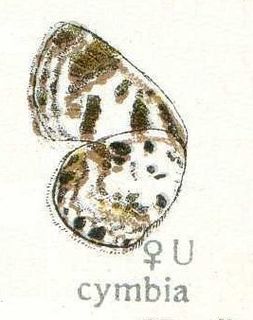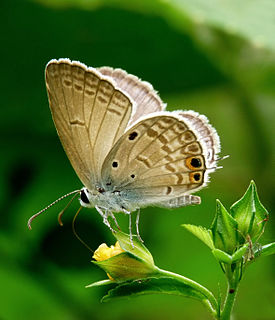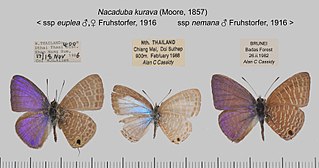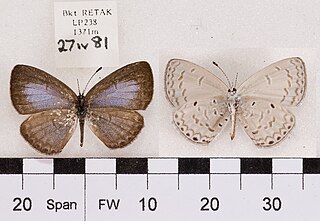
Tarucus theophrastus, the common tiger blue, pointed Pierrot or African Pierrot, is a small butterfly found in the Old World tropics. It belongs to the lycaenids or blues family.

Azanus ubaldus, the bright babul blue, desert babul blue, or velvet-spotted blue, is a small butterfly found in India, the Middle East and Africa that belongs to the lycaenids or blues family.

Azanus jesous, the African babul blue or topaz-spotted blue, is a small butterfly found in Africa, Egypt, Syria, India, Sri Lanka and Myanmar that belongs to the lycaenids or blues family.

Niphanda cymbia, the pointed Pierrot, is a small butterfly found in northern India, Burma and northern Borneo that belongs to the lycaenids or blues family.
Elkalyce kala, the black Cupid, is a small butterfly found in India that belongs to the lycaenids or blues family.

Chilades lajus, the lime blue, is a small butterfly found in India, Sri Lanka, Myanmar, Taiwan, Hong Kong, Hainan, Mangulam Island, Sulawesi and the Philippines that belongs to the lycaenids or blues family.

Euchrysops cnejus, the gram blue, is a small butterfly found in India that belongs to the lycaenids or blues family found in India to Australia.

Chilades trochylus, the grass jewel, is a small butterfly found in Africa, Arabia, southern Europe, India and southern Asia that belongs to the lycaenids or blues family.

Lycaenopsis marginata, the margined hedge blue, is a small butterfly found in India that belongs to the lycaenids or blues family.

Albulina younghusbandi is a species of lycaenid butterfly found in Asia.
Polyommatus sarta is a species of lycaenid butterfly found in Asia.

Petrelaea dana, the dingy lineblue, is a species of lycaenid butterfly found in Indomalayan realm.

Nacaduba kurava, the transparent six-line blue, is a species of Lycaenidae butterfly found in Asia and Australia.

Nacaduba berenice, the rounded six-line blue, is a species of lycaenid butterfly found in Indomalayan realm.
Plebejus christophi, the small jewel blue, is a small butterfly found in Asia that belongs to the lycaenids or blues family.

Albulina omphisa, the dusky green underwing, is a species of blue (Lycaenidae) butterfly found in Asia.

Agriades jaloka, the Jaloka mountain blue, is a butterfly in the family Lycaenidae. It is found in Asia.

Catochrysops strabo, the forget-me-not, is a small butterfly found in Asia that belongs to the lycaenids or blues family. It is found in Sri Lanka, India, from Sikkim to Indochina and in Sundaland, Sulawesi and the Philippines.

Monodontides musina, the Swinhoe's hedge blue, is a butterfly of the family Lycaenidae. It is found in South-East Asia, including India.

Catopyrops ancyra, commonly known as Felder's lineblue, is a species of butterfly belonging to the lycaenid family described by Cajetan Felder in 1860. It is found in the Indomalayan and Australasian realms.


















